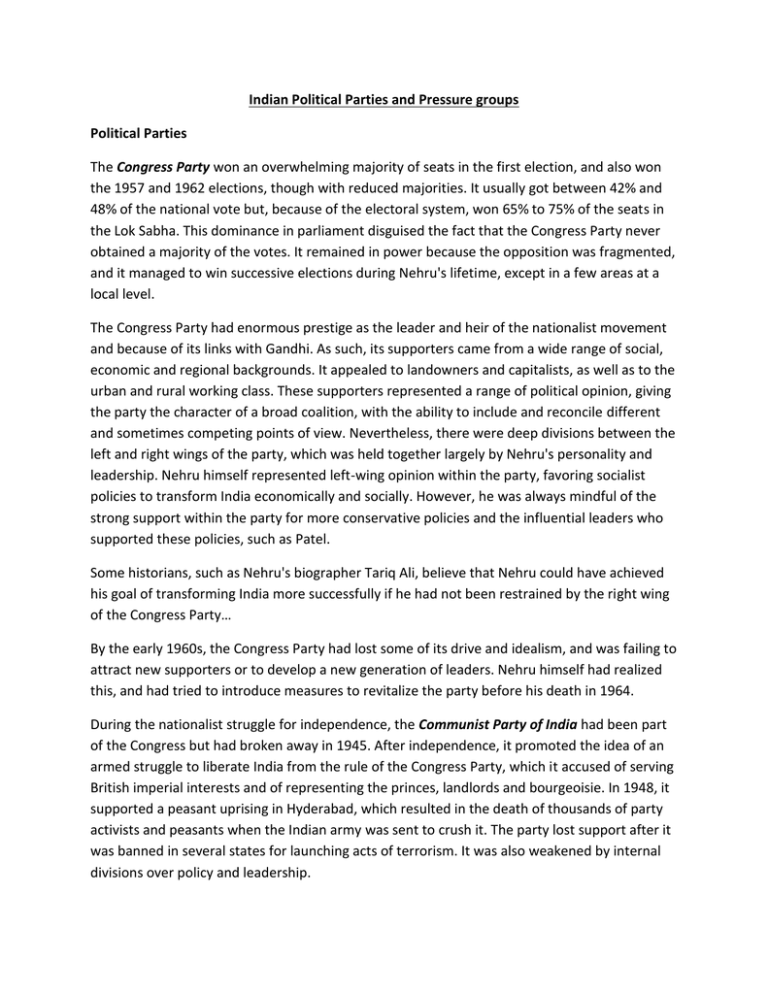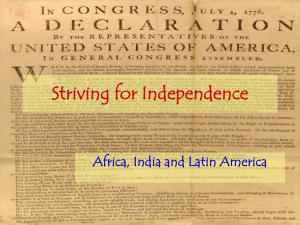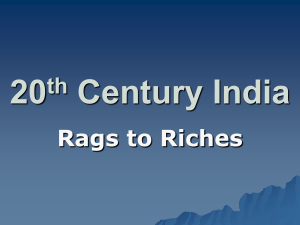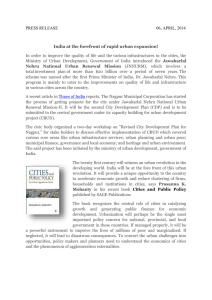Indian Political Parties and Pressure groups Political Parties The
advertisement

Indian Political Parties and Pressure groups Political Parties The Congress Party won an overwhelming majority of seats in the first election, and also won the 1957 and 1962 elections, though with reduced majorities. It usually got between 42% and 48% of the national vote but, because of the electoral system, won 65% to 75% of the seats in the Lok Sabha. This dominance in parliament disguised the fact that the Congress Party never obtained a majority of the votes. It remained in power because the opposition was fragmented, and it managed to win successive elections during Nehru's lifetime, except in a few areas at a local level. The Congress Party had enormous prestige as the leader and heir of the nationalist movement and because of its links with Gandhi. As such, its supporters came from a wide range of social, economic and regional backgrounds. It appealed to landowners and capitalists, as well as to the urban and rural working class. These supporters represented a range of political opinion, giving the party the character of a broad coalition, with the ability to include and reconcile different and sometimes competing points of view. Nevertheless, there were deep divisions between the left and right wings of the party, which was held together largely by Nehru's personality and leadership. Nehru himself represented left-wing opinion within the party, favoring socialist policies to transform India economically and socially. However, he was always mindful of the strong support within the party for more conservative policies and the influential leaders who supported these policies, such as Patel. Some historians, such as Nehru's biographer Tariq Ali, believe that Nehru could have achieved his goal of transforming India more successfully if he had not been restrained by the right wing of the Congress Party… By the early 1960s, the Congress Party had lost some of its drive and idealism, and was failing to attract new supporters or to develop a new generation of leaders. Nehru himself had realized this, and had tried to introduce measures to revitalize the party before his death in 1964. During the nationalist struggle for independence, the Communist Party of India had been part of the Congress but had broken away in 1945. After independence, it promoted the idea of an armed struggle to liberate India from the rule of the Congress Party, which it accused of serving British imperial interests and of representing the princes, landlords and bourgeoisie. In 1948, it supported a peasant uprising in Hyderabad, which resulted in the death of thousands of party activists and peasants when the Indian army was sent to crush it. The party lost support after it was banned in several states for launching acts of terrorism. It was also weakened by internal divisions over policy and leadership. At the end of 1951, the party changed its tactics, on the advice of the Soviet Union, abandoned its armed struggle and decided to participate in the first general election. Although it won less than 5% of the votes, it emerged as the largest opposition party, and therefore the official opposition. Support for the Communist Party came from peasants, workers, students and the intelligentsia, and it was stronger in certain regions of India, especially in the south and in Bengal. In the 1957 state elections, it won a majority in the southern state of Kerala, where it proceeded to launch land reform and educational reform programs, before the communist chief minister was removed from office by the central government. On a national level, the Communist Party improved its position in the 1957 and 1962 general elections, winning nearly 10% of the national vote in 1962. However, a surprise attack by India's communist neighbor later that year, when the Chinese army invaded parts of northern India, was a serious setback for the party. The Socialist Party had also been part of the Congress but broke away in 1948 to function as a separate party. It accused the Congress Party of betraying the poor, and representing the landlords and capitalists rather than the workers and peasants. Historians such as Bipan Chandra believe that the decision seriously weakened the left wing of Congress, and made it more difficult for Nehru to introduce more radical reforms because of the strength of the conservative forces within the Congress Party. In the 1952 elections, the Socialist Party won only 12 seats in the Lok Sabha, although it gained over 10% of the votes, which was more than any other opposition party and twice as many as the Communists. It later merged with another party formed by Congress dissidents, the Kisan Mazdoor Praja Party (KMPP), which claimed to be following more closely the teachings of Gandhi. However, later splits weakened the Socialist Party and support for it declined in subsequent elections. The Bharatiya Jan Sangh (BJS) was a Hindu nationalist party which challenged the secular nature of the Indian state. Most of its leaders and active members were also members of the Rashtriya Swayamsevak Sangh (RSS), a militaristic Hindu nationalist group. Jan Sangh promoted Hindu culture, religion and traditions and, using the slogan “one country, one culture, one nation”, wanted to unite all Hindus. It did not have much support in the south because of its strong support for Hindi as the national language. It was strongly anti-Muslim, and treated India’s Muslims with suspicion, questioning their loyalty to India. Initially it wanted the reunification of India by absorbing Pakistan, but it later abandoned this aim. It accused Nehru and the Congress Party of appeasing Muslims. At first Nehru saw Jan Sangh as a challenge because he knew that it expressed the views of some of the more right-wing members of Congress. However, in the 1952 general election, Jan Sangh won only 3% of the vote, indicating that there was little support for a communalist Hindu party. Pressure Groups The wide range of religions, languages, culture and ethnic groups, as well as castes, resulted in the formation of several influential pressure groups. The Rashtriya Swayamsevak Sangh (RSS) was a right-wing Hindu nationalist group, whose members opposed the creation of a secular state in India. They were openly anti-Muslim and had a vision of India as a land of, and for, Hindus. They portrayed Muslims as a hostile and alien element in India society. Claiming to be a cultural rather than a political organization, they did not contest elections, but instead formed uniformed paramilitary cells. At the time of independence, they drew support from students, refugees and the urban lower middle classes. According to historian Ramachandra Guha, Nehru believed that they were responsible for much of the violence that accompanied partition. They were opposed to Gandhi’s efforts to reduce communal violence in Bengal and Delhi, his conciliatory gestures towards Muslims, and his announced intention of visiting Pakistan. They promoted a campaign of hatred against Gandhi, accusing him of being a traitor. It was in this atmosphere that Gandhi was assassinated in January 1948 by Nathuram Godse, an active supporter of the RSS. Although the RSS itself was not actively involved in the assassination, the movement was banned for a while and support for Hindu nationalism declined. The Akali Dal was a Sikh separatist group campaigning for the establishment of a Punjabispeaking state. Some even wanted an independent Sikh state. In 1955 the Akali Dal held mass demonstrations demanding greater autonomy for the Sikhs, which were forcefully put down by the Indian army. After Nehru’s death a reorganization of state borders took place, ostensibly along linguistic rather than religious lines, and Punjab was separated from Haryana, with Punjabi and Hindi as their respective official languages. The Scheduled Caste Federation was established in 1942 by Dr. B.R. Scheduled Caste – the Ambedkar, a respected lawyer educated in the United States and Britain. government’s name As an Independent in the first government, he served as Law Minister for the Untouchables, who were outside the and played a leading role in drafting the constitution. Although the caste system. Gandhi Congress Party, and Nehru in particular, denounced “casteism” and put called them Harijans in motion legislation to raise the lower castes, Ambedkar criticized the (Children of God). Congress government for not doing enough. He believed that They preferred to be independence had not meant freedom for the scheduled castes, and he called Dalits (meaning oppressed). described the situation of these caste members as a continuation of the tyranny, oppression and discrimination that had always existed. The party stood in the 1952 elections but its candidates were defeated, mainly by Congress candidates, in the seats reserved for the scheduled castes. In the next election, the Congress Party won 64 of the 76 reserved seats. By this time Ambedkar had stopped playing an active role in politics. As a rejection of Hinduism and its discriminatory caste system, he converted to Buddhism and focused on persuading his fellow caste members to do the same. The situation of the scheduled castes was taken up again as a political cause by the Dalit Panthers in the 1970s. The Death of Nehru In January 1964, Nehru suffered a stroke, and in May of that year he died. He had dominated Indian politics for decades, first as a leader of the nationalist movement alongside Gandhi, and then as the first prime minister of independent India. He is widely admired for his commitment to democracy and secularism, and for the role he played in establishing a united and democratic India. Many historians share similar positive views about the values Nehru prized, his qualities as a leader and his role in establishing a multi-party democracy in India. Barbara and Thomas Metcalf observe that his solid support for democratic processes ensured that these became an entrenched feature of the way democracy functions in India. According to Ramachandra Guha, Nehru represented the voice of democracy against dictatorship, and of secularism against narrow communal interests. Bipan Chandra provides a balanced view, describing Nehru as a visionary leader but one who failed to find a way of putting his ideals into practice. He points out some of the areas that were neglected by Nehru’s government, creating problems for the future. These included the education system, which was not reformed and failed to reach the majority of people; the failure to launch an effective mass struggle against communalism as an ideology; and the inadequate implementation of land reforms, leaving a legacy of economic inequality, social oppression and political violence in rural India. These were some of the political, economic and social challenges facing India…

![South Asia [India]](http://s3.studylib.net/store/data/009702364_1-19e39c605abd17ea47a31ad7fcd12c7d-300x300.png)





